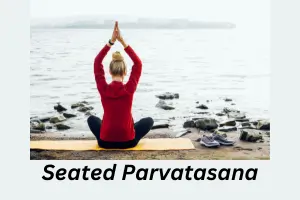Introduction
Seated Mountain yoga Pose, also known as Seated Parvatasana , is a foundational yoga posture that emphasizes stability and mindfulness.
This seated position allows practitioners to cultivate a sense of inner peace, focus, and alignment.
Unlike many dynamic asanas, Seated Mountain encourages stillness and introspection, making it an excellent pose for meditation and grounding oneself.

Seated Mountain is often practiced at the beginning of a yoga session to promote relaxation and prepare the body for deeper stretches.
It serves as a reminder to maintain an erect posture and cultivate a strong foundation, similar to that of a mountain.
Steps to Perform Seated Mountain Yoga Pose/Seated Parvatasana
- Find a Comfortable Seated Position: Start by sitting on a yoga mat or a comfortable surface. You can cross your legs in front of you or sit on your heels. If sitting on the floor feels uncomfortable, use a cushion or folded blanket for support.
- Align Your Spine: Sit up tall, ensuring that your spine is straight. Imagine a string pulling the crown of your head upward. Your shoulders should be relaxed and rolled back, away from your ears.
- Position Your Hands: Place your hands on your knees or thighs, palms facing up for an open posture or palms facing down for grounding. If you prefer, you can also bring your hands together in front of your heart in a prayer position.
- Engage Your Core: Lightly engage your core muscles to support your spine. This will help maintain an upright position without straining your back.
- Close Your Eyes: If comfortable, gently close your eyes to enhance your focus and turn your attention inward. This will help you cultivate a sense of calm and awareness.
- Breathe Deeply: Take slow, deep breaths through your nose. Inhale deeply, allowing your abdomen to expand, and exhale completely, letting go of any tension. Focus on your breath and the sensations in your body.
- Hold the Pose: Maintain this position for 5 to 10 minutes, or as long as you feel comfortable. Allow your breath to flow naturally, and observe any thoughts or feelings that arise without judgment.
- Come Out of the Pose: When you’re ready to end the pose, gently open your eyes and take a moment to notice how you feel. Slowly release your hands and come back to a comfortable seated position before transitioning to another pose or activity.
Benefits of Seated Mountain Yoga Pose/Seated Parvatasana
- Improves Posture: Seated Mountain encourages awareness of body alignment, promoting better posture and reducing strain on the spine.
- Enhances Focus and Concentration: This pose fosters mindfulness and mental clarity, helping to sharpen focus and enhance concentration during meditation or daily activities.
- Promotes Relaxation: The seated position combined with deep breathing helps calm the nervous system, reducing stress and promoting a sense of relaxation.
- Strengthens Core Muscles: Engaging the core while maintaining an upright position helps strengthen abdominal muscles, contributing to overall core stability.
- Increases Flexibility in Hips: Sitting in this pose can help improve hip flexibility and mobility, which is beneficial for other seated or standing poses.
- Encourages Mindfulness: Seated Mountain invites practitioners to cultivate awareness of their thoughts and feelings, encouraging a deeper connection to their inner selves.
- Prepares for Meditation: This pose serves as an excellent preparatory position for meditation, helping to create a calm and focused mindset.
Precautions and Contraindications for Seated Mountain Yoga Pose/Seated Parvatasana
- Knee or Hip Issues: Individuals with knee or hip problems should approach this pose with caution. It may be necessary to use props, such as cushions or blankets, for added support.
- Pregnancy: Pregnant women should consult with their healthcare provider before practicing Seated Mountain, especially in the later stages of pregnancy.
- Back Pain: Those with chronic back pain should be cautious when sitting for extended periods. It’s essential to listen to your body and adjust the pose as needed.
- Recent Surgery: Individuals recovering from surgery in the lower body or abdomen should seek medical advice before attempting this pose.
- Difficulty Sitting Cross-Legged: If sitting cross-legged is uncomfortable, you can modify the pose by sitting on a chair with your feet flat on the ground.
- Fatigue: Practitioners feeling overly fatigued may find it challenging to maintain focus in this pose. It’s advisable to take rest or practice a more restorative pose.
Conclusion
- Seated Mountain Pose (Seated Parvatasana) is a fundamental yoga posture that offers numerous benefits for both the body and mind.
- Its emphasis on alignment, breathing, and mindfulness makes it an essential practice for yogis of all levels.
- By incorporating Seated Mountain into your routine, you can enhance your physical stability, cultivate mental clarity, and promote a sense of inner peace.
- As you practice this pose, focus on the sensations in your body and the rhythm of your breath.
- Allow yourself to embrace stillness and cultivate a deeper connection with your inner self.
- Whether you use it as a warm-up for more dynamic poses or as a meditative practice, Seated Mountain serves as a powerful reminder of the strength and serenity that resides within you.
